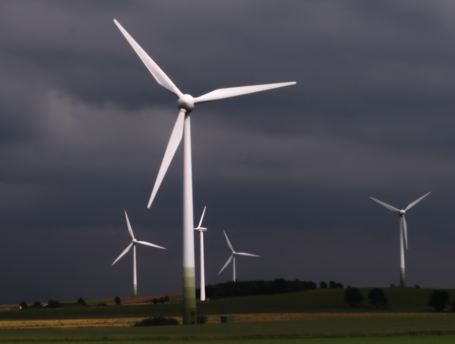
Wind turbines in Saxony, Germany. Wind turbines don't interfere with other land uses such as farming.
Wind turbines convert the energy of the wind into electricity.
The blades of the turbine are aerodynamically shaped just like an aircraft wing,[1] so that when the wind passes them it forces them to rotate. In this process the wind loses speed and hence energy, which has now been transferred to the rotational energy of the blades.
The rotating blades are then attached, through a gear system,[2] to a generator that sits in the pod[3] behind the blades. The generator converts the rotational motion into electricity, which is then fed down the tower to where it is needed.
The amount of energy obtainable from the wind depends strongly on the wind speed: every doubling of the wind speed increases the power eightfold.[4] A doubling of the blade length quadruples the energy available. A modern turbine with a diameter of 90 metres can generate around 2.5 megawatts of power in ideal conditions, which is enough to power 2500 households in the developed world.[5] Often turbines are grouped together in "farms" to provide more power.[6]
See Turbine Aerodynamics section in How Wind Power Works from How Stuff Works.
The wind blades generate lift in the direction of rotation just like an airplane wing.
The gearbox converts the turbine rotation speed of 15 to 20 rotations per minute (rpm) up to the 1500 to 2000 rpm required by the generator. It can have several steps depending on the wind conditions.
The gearbox and generator are known as the "drive-train".
Because gearboxes are the most complicated part of the wind turbine, they need regular maintenance. This can be a problem, especially for offshore deployments, so some companies are developing direct-drive or "gearless" drive-trains. See article Building Bigger, Better Wind Turbines in July 2011 Technology Review.
The pod behind the blades is known as a nacelle.
See The Physics of Wind Power chapter from the online book Sustainable Energy - Without the Hot Air by David J.C. MacKay (2008).
The kinetic energy in the wind passing a turbine during time t at a constant velocity of v is 1/2 mv^2 = 1/2 Avtdv^2 where m is the mass of the wind, which has been re-expressed in terms of the area of the turbine A and the density d of the air.
With an efficiency factor f and an area A = (pi) r^2 (r is the radius of the turbine) the power is then P = 1/2 f(pi)dr^2v^3.
So double wind speed and you multiply the power by eight. Double the radius and you multiply by four.
Wind turbines are designed to shut down in high winds to avoid damage.
http://www.scadasolutions.com/livesite/wind-tutorial.shtml:
"Wind turbines being manufactured now have power ratings ranging from 250 watts to 5 megawatts (MW). Example: A 10-kW wind turbine can generate about 10,000 kWh annually at a site with wind speeds averaging 12 miles per hour, or about enough to power a typical household. A 5-MW turbine can produce more than 15 million kWh in a year--enough to power more than 1, 400 households. The average U.S. household consumes about 10,000 kWh of electricity each year."
Rated capacity used in 2009 report is 2.5MW for onshore and 3.5 for offshore. Rated capacity means maximum efficiency in perfect conditions.
Biggest-capacity wind turbine is Enercon E-126 at 7MW?
The "capacity factor" of a site is the ratio of the actual power produced in a year to the theoretical rated capacity of the turbine. Typical capacity factors are in the range of 20% for weak sites to 40% for good sites (figures from Wikipedia: Wind power).
Assume household uses 1kW.
It's worth noting that the energy used to produce a wind turbine can be reclaimed by the operation of the turbine in a few months.
Often windy areas are large, so several turbines can be grouped together to take advantage of this. Turbines must be spaced to minimize interference in airflow caused by interactions among individual turbines.
Other location issues to consider: wind is low over forested areas, due to turbulence caused by surface roughness.
There are onboard computers to keep them pointed in best direction for the wind.
Most large wind turbines rotate around a horizontal axis like a propellor, but some designs have blades rotating around a vertical axis like an egg-beater.
Author: Tom Brown
Copyright: public domain
Date last modified: 11th Oct 2011
Peer-review status: Not yet peer-reviewed
http://commons.wikimedia.org/wiki/File:20090717_Windpark_bei_Sayda_1.png: By Eclipse.sx (Own work) [CC-BY-SA-3.0 (www.creativecommons.org/licenses/by-sa/3.0) or GFDL (www.gnu.org/copyleft/fdl.html)], via Wikimedia Commons - cropped
http://commons.wikimedia.org/wiki/File:Scout_moor_gearbox,_rotor_shaft_and_brake_assembly.jpg: Paul Anderson [CC-BY-SA-2.0 (www.creativecommons.org/licenses/by-sa/2.0)], via Wikimedia Commons